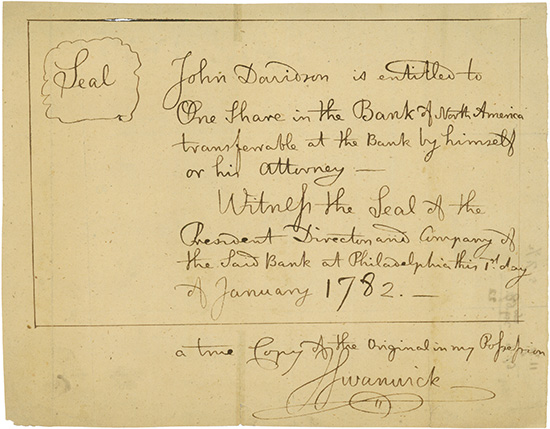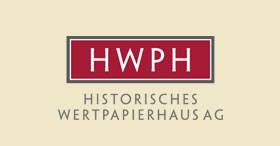Ingelsberg 17 b
D- 85604 Zorneding
Deutschland / Germany
Tel.: +49 (0)8106 - 2461-86
Fax: +49 (0)8106 - 2461-88
E-Mail: auktion@hwph.de
–
|
|
||||
| 584 | ||||
| Bank of North America | ||||
| Philadelphia | ||||
| USA | ||||
| Amerika | ||||
| Philadelphia, 01.01.1782, notarielle Abschrift einer Aktie, o. Nr., 19 x 24,3 cm, schwarz, beige, Knickfalten mit Einrissen, teils repariert, Erhaltung VF, Udo Hielscher hat das vorliegende Stück im Juni 1985 bereits in einem Artikel im HP Magazin besprochen, er erläutert: „Die Bezeichnung „a true Copy“ auf der Urkunde ist nicht mit dem heutigen Begriff „Kopie“ zu verwechseln. Noch weitgehend ohne eigene Rechtstradition mußten sich die Amerikaner wohl oder übel an europäischen Vorbildern orientieren. [Jakob] Schmitz vermutet wohl mit Recht, daß bei sehr frühen Aktien „gelegentlich zwei Ausfertigungen ausgestellt (wurden): die eine erhielt der Aktionär, die andere verblieb in den Akten der Gesellschaft ...“ bzw. bei einem Treuhänder.“, seit über 38 Jahren ist nur dieses eine Exemplar bekannt, das nach einer Sammlungsauflösung nun wieder verfügbar wird. R12! | ||||
| Philadelphia, 1 January 1782, notary copy of a Share, o. Nr., 19 x 24.3 cm, black, beige, folds with tears, partially repaired with tape, conditino VF, Udo Hielscher has already reviewed the offered share certificate in an article in German HP Magazine in June 1985. He explains: „The designation „a true copy“ on the deed is not to be confused with today’s term „copy“. Still largely without their own legal tradition, the Americans had to orient themselves whether they liked it or not on European models. [Jakob] Schmitz is probably right in assuming that in the case of very early shares „occasionally two certificates (were) issued: one was given to the shareholder, the other remained in the files of the company ...“ or with a trustee.“, only this certificate is known for more than 38 years, it becomes available from an old collection. R12! | ||||
| VF | ||||
 |
||||
| Die Bank of North America war die erste zugelassene Bank der Vereinigten Staaten von Amerika. Sie fungierte de facto als erste Zentralbank des Landes. Sie wurde vom Kongress der Konföderierten am 26. Mai 1781 gegründet und am 7. Januar 1782 in Philadelphia eröffnet. Die Gründung der Bank of North America war das Werk des Superintendent of Finance Robert Morris. Er legte am 17. Mai 1781 einen Plan zur Errichtung der Bank vor, der auch Empfehlungen des ersten US-Finanzministers, Alexander Hamilton, enthielt. „Die avisierte Eigenkapitalausstattung mit 10 Mio. $ erwies sich jedoch rasch als illusorisch. Selbst von dem drastisch auf 400.000 $ reduzierten Betrag (1.000 Aktien à 400 $) konnten aufgrund der unsicheren Lage bis Ende 1781 lediglich rund 175 Stück beim Publikum untergebracht werden. Die meisten Aktien erwarb Morris daher zunächst für Rechnung der Vereinigten Staaten. Das Geld dafür bestand im Wesentlichen aus ausländischen Edelmetallmünzen aus französischen Darlehen, die via Boston heimlich durch die englischen Linien nach Philadelphia gebracht worden waren.“ (Udo Hielscher, Die Ursprünge von „Wall Street“ und des amerikanischen Kapitalmarktes im Spiegel Historischer Wertpapiere, erschienen im Verlag der HWPH AG). William Bingham, der damals wohl reichste Mann Amerikas, erwarb rund 9,5 Prozent der verfügbaren Aktien. Der größte Anteil, 63,3 Prozent, wurde jedoch im Namen der Regierung der Vereinigten Staaten von Amerika von Robert Morris gekauft. Dies hatte zur Folge, dass die Bank mit großen Einlagen an Gold- und Silbermünzen sowie Wechseln kapitalisiert wurde. Anschließend gab sie neues Papiergeld aus, das durch diesen Vorrat gedeckt war. Die Bank gab eigene Banknoten heraus, welche die problematischen kontinentalen Banknoten ablöste. Um Fälschungen vorzubeugen, wurden diese Banknoten auf Papier gedruckt, auf dessen Rückseite farbige Fasern eingepresst waren. Die Banknoten enthielten das Versprechen, auf Verlangen in Silber eingetauscht werden zu können. Dennoch hatte die Bank zunächst Schwierigkeiten, das Volk von ihrer Bonität zu überzeugen. Um den Eindruck zu erwecken, dass sie über große Reserven verfügte, holte die Bank regelmäßig große Geldkassetten aus dem Keller und zeigte sie dem Publikum. Nachdem alle Aktien platziert waren, nahm auch das Vertrauen in die Banknoten zu. Ein ganz wichtiger Punkt dabei war, dass es Amerikanern fortan erlaubt war, Steuern mit Banknoten der Bank of North America zu zahlen, was ihnen den entscheidenden Aspekt des gesetzlichen Zahlungsmittels verlieh. Obwohl die Bank einen wesentlichen Beitrag zur Finanzierung des Amerikanischen Unabhängigkeitskrieges leistete, lehnte die Regierung von Pennsylvania ihre Privilegien ab. Das machte die Bank als Notenbank ungeeignet. Der Kongress genehmigte daher 1791 eine neue Bank, die First Bank of the United States, während die Bank of North America als Privatunternehmen weiter bestand. Die Aktien der Gesellschaft waren neben denen der First Bank of the United States und der Bank of New York, die ersten, die an der New Yorker Börse gehandelt wurden. 1923 fusionierte die Bank mit der Commercial Trust Company zur Bank of North America and Trust Company, die 1929 mit der Pennsylvania Company for Insurances on Lives and Granting Annuities fusionierte. Diese als Pennsylvania Banking and Trust agierende Bank fusionierte 1955 mit der First National Bank zur First Pennsylvania Banking and Trust Company, die 1991 von der Core States Financial und 1998 von der First Union / Wachovia und schließlich 2008 von Wells Fargo übernommen wurde. | ||||
| The Bank of North America was the first chartered bank in the United States of America. It served as the country’s first de facto central bank. It was chartered by the Congress of the Confederation on May 26, 1781, and opened in Philadelphia on January 7, 1782. The formation of the Bank of North America was the work of the Superintendent of Finance Robert Morris. He submitted a plan for establishing the bank on May 17, 1781, which included recommendations from the first U.S. Secretary of the Treasury, Alexander Hamilton. „However, the advised equity capital of $10 million quickly proved illusory. Even of the amount drastically reduced to $ 400,000 (1,000 shares at $ 400 each), only about 175 could be placed with the public by the end of 1781 because of the uncertain situation. Morris therefore initially acquired most of the shares for the account of the United States. The money for this consisted mainly of foreign precious metal coins from French loans, which had been secretly brought to Philadelphia via Boston through the English lines.“ (Udo Hielscher, Die Ursprünge von „Wall Street“ und des amerikanischen Kapitalmarktes im Spiegel Historischer Wertpapiere, published by HWPH AG). William Bingham, probably the richest man in America at that time, acquired round about 9.5 percent of the total shares of the Bank of North America. However, the largest share, 63.3 percent, was purchased on behalf of the government of the United States of America by Robert Morris. As a result, the bank was capitalised with large deposits of gold and silver coins and bills of exchange. The bank then issued new paper money backed by this stock. The Bank of North America issued its own banknotes, which replaced the problematic continental banknotes. To prevent counterfeiting, these bills were printed on paper with colored fibers pressed into the back. The banknotes contained the promise that they could be exchanged for silver on demand. Nevertheless, the bank initially had difficulty convincing the people of its creditworthiness. To give the impression that it had large reserves, the bank regularly brought out large cash boxes from the cellar and showed them to the public. Once all the shares had been placed, confidence in the banknotes also increased. A very important point here was that Americans were henceforth allowed to pay their taxes with Bank of North America bills, which gave them the crucial aspect of legal tender. Although the Bank of North America contributed significantly to the financing of the American War of Independence, the Pennsylvania government rejected its privileges. This made the bank unsuitable as a bank of issue. Congress therefore authorised a new bank, the First Bank of the United States, in 1791, while the Bank of North America continued as a private corporation. Bank of North America, First Bank of the United States, and Bank of New York were the first shares traded on the New York Stock Exchange. In 1923, the bank merged with the Commercial Trust Company to become the Bank of North America and Trust Company, which merged in 1929 with the Pennsylvania Company for Insurances on Lives and Granting Annuities. That company, operating as the Pennsylvania Company for Banking and Trust, merged with the First National Bank in 1955 to become The First Pennsylvania Banking and Trust Company, which was acquired by CoreStates Financial Corporation in 1991, by First Union/Wachovia in 1998, and by Wells Fargo in 2008. | ||||













